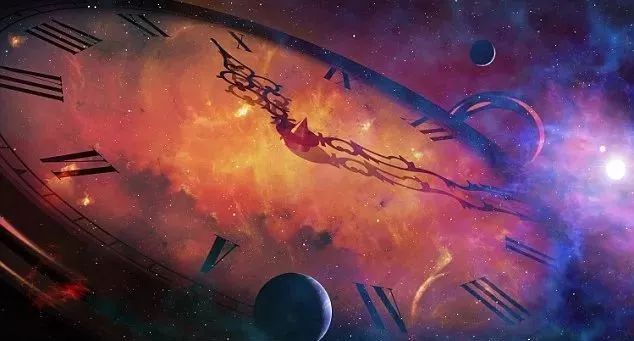
If the Sun exhausts all its hydrogen energy, how will life on Earth survive? Can humanity find a new home in the universe? The outlook seems bleak: current observations indicate that the universe will continue to expand forever. This means that the density of matter and energy will become increasingly sparse, making energy collection more difficult. By that time, living beings may have to seek energy from black holes and cosmic strings.
Written by | Lawrence Krauss
Glenn Starkman
Translated by | Jianrong Shi
The Sun will eventually consume all its hydrogen energy, and at that point, all life on Earth as we know it will come to an end, except for humanity, which may continue. Our descendants will inevitably face death and disaster, and pain and worry may never disappear, but it is likely that some of them will find new homes, spreading to all corners of the universe, just as Earth’s life forms are distributed in all habitable places.
The outcome may not be so straightforward. Although scientists do not yet fully understand the nature of life and the evolution of the universe, they can still make informed predictions about the fate of life. Current cosmological observations suggest that the universe will expand forever, rather than contracting after reaching a maximum size as previously thought. Therefore, humanity will not be crushed into fragments by the universe’s violent contraction, and human civilization will not be entirely obliterated as once imagined. It seems that eternal expansion may be a good thing for life. So, what could possibly prevent a sufficiently intelligent life form, capable of continuously finding resources, from existing forever?
Endless Eternity, Endless Wasteland
The prosperity of life depends on energy and information. The most fundamental scientific principles show that even in an infinite cycle, humanity can only acquire a limited amount of energy and information. For the continuation of life, we must face the gradually diminishing energy resources and limited information. It is certain that in such a scenario, conscious beings cannot exist forever.
Over the past century, futurists have oscillated between optimism and pessimism. Shortly after Darwin’s confident predictions, scientists began to worry about the “heat death” of the universe, where the entire universe would reach a uniform temperature and cease to change. The discovery of cosmic expansion in the 1920s alleviated this concern, as expansion would prevent the universe from reaching a state of “heat death” equilibrium.
However, few cosmologists have considered the implications of eternal expansion on life. It wasn’t until 1979 that Freeman Dyson of the Institute for Advanced Study in Princeton published a classic paper on the effects of eternal expansion on biology. Dyson’s ideas were inspired by earlier research by Jamal Islam. Since Dyson’s article was published, physicists and astronomers have periodically revisited this issue. Observations in 1998 indicated that we would have a very different and longer-term future than previously envisioned. Inspired by this, we began to learn to view the problem from a different perspective.
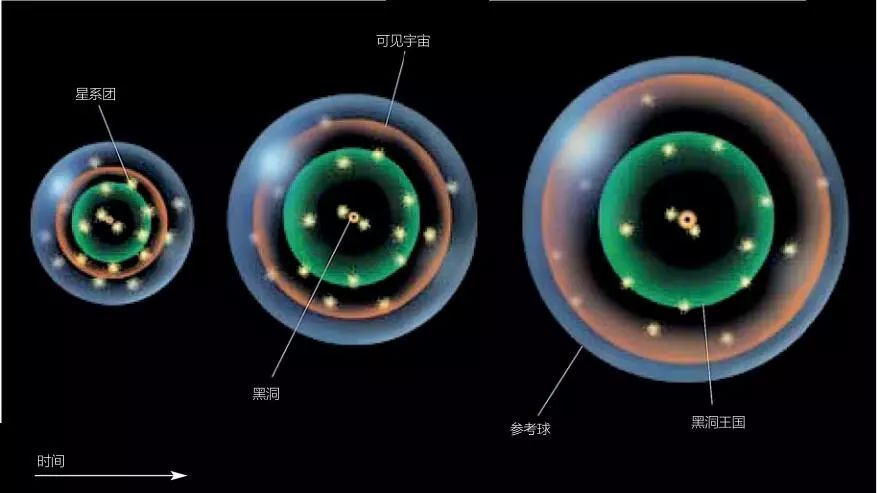
Energy collection strategies: Physicist Steven Frautschi from the California Institute of Technology illustrated that survival will become increasingly difficult in about 10100 years. Among various cosmic events, as the universe expands, the diversity of energy within any reference sphere (blue sphere) will also expand, and more parts will become visible (red sphere). A highly evolved civilization could convert the matter plundered from the black hole kingdom (green sphere) into energy. However, as this kingdom grows, the cost of acquiring new territory increases, and the speed of conquest struggles to keep pace with the rate at which matter becomes sparse. In fact, matter becomes so diffuse that this civilization cannot create a sufficiently large black hole to collect it.
In the past 10 billion years, the universe has gone through many stages. Scientists have gathered enough observational facts about the early universe to know it was unimaginably hot and dense. Since then, the universe has begun to expand and cool. For several hundred thousand years afterward, radiation began to dominate, and the cosmic microwave background radiation we know today is a remnant of that era. Next, matter began to dominate, gradually forming large cosmic structures. If current observations are correct, our universe is beginning to accelerate in its expansion. This suggests that a strange new energy, possibly arising from the very fabric of space itself, is beginning to dominate.
Life has become accustomed to relying on stars, but stars inevitably die, and their birth rate has been significantly declining since about 10 billion years ago. In about 100 trillion years, stars in the conventional sense will no longer exist, and a new era will emerge. Some processes that are currently too slow to notice will become significant: such as the diffusion of planetary systems due to close encounters with stars, the possible decay of ordinary and exotic matter, and the slow evaporation of black holes.
If intelligent life can adapt to changes in their environment, what fundamental limitations will they face? In a potentially infinite eternal universe, one might hope that a sufficiently advanced civilization could gather an endless supply of matter, energy, and information. But surprisingly, this is not the case. Even with long-term effort and careful design, living beings can only gather a finite amount of matter, energy, and information. And frustratingly, the number of particles, ergs (a unit of energy), and bits may be infinite, so this failure is not due to a lack of resources, but rather the difficulty of collecting them.
The culprit behind this dilemma is precisely the factor that allows life to exist permanently: the expansion of the universe. As the universe expands, the average energy density of ordinary energy decreases. If the radius of the universe doubles, the density of atoms will decrease by a factor of eight. For light waves, this decline is even more severe. Their energy density will drop to one-sixteenth of the original, as the expansion stretches the wavelengths, thereby weakening their energy.
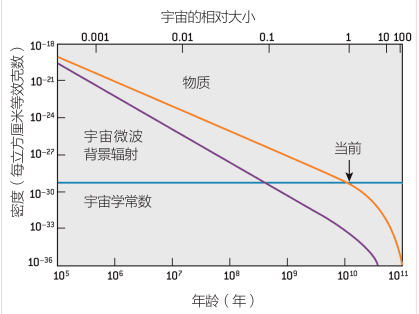
The dilution effect of cosmic expansion on different forms of energy varies. Ordinary matter (orange) decreases in proportion to volume, while cosmic microwave background radiation (purple) decreases even faster, as light waves will be stretched to microwave or longer wavelengths. The energy determined by the cosmological constant (blue), at least from the current theoretical perspective, will remain unaffected.
Due to severe “dilution,” energy collection becomes increasingly troublesome. Intelligent life has two options: let matter come to them or actively seek it out.
For the former, the best long-term strategy is to let gravity do the work. Among all natural forces, only gravity and electromagnetism can attract objects from arbitrary distances. However, electromagnetic forces are usually shielded. The reason is that oppositely charged particles interact to achieve charge balance, so ordinary objects are electrically neutral and not affected by long-range electric and magnetic forces. Gravity, on the other hand, is unshieldable, as matter and radiation particles only attract through gravity and do not cancel each other out.
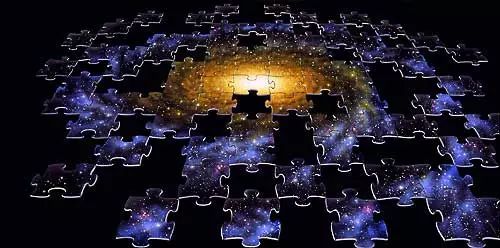
Is Fate Determined?
Even gravity must struggle against the expanding universe, as expansion increases the distance between objects, thereby weakening their gravitational attraction. Except for one special case described below, gravity ultimately cannot gather large amounts of matter together. In fact, our universe may have already passed this point—galaxy clusters may be the largest aggregates of matter bound together by gravity.
The only exception can occur when expansion and contraction reach a balance, in which case gravity can continuously accumulate large amounts of matter. However, this scenario contradicts current observational facts. Even if this were possible, it would still be unfeasible: because in that case, in about 1033 years, the matter around us will become so dense that most of it will collapse into black holes. Inside black holes, the situation is not optimistic. On Earth, we often say that all roads lead to Rome, but inside a black hole, all matter will reach a common endpoint in a finite time—the center of the black hole, where death and disintegration are inevitable outcomes.
Sadly, the strategy of actively seeking energy is no better than the passive approach. Cosmic expansion weakens kinetic energy, so explorers can only squander existing energy to maintain their speed. Even in the most optimistic scenario—where all energy moves at the speed of light towards a black hole and is collected without loss—humanity can only obtain infinite energy from within or near black holes. In 1982, Steven Frautschi from the California Institute of Technology studied this possibility. He concluded that the energy obtainable from black holes would rapidly diminish, while the energy expended to collect that energy would not decrease significantly. Recently, we re-examined this possibility and found that the situation is even worse than Frautschi anticipated: A black hole capable of indefinitely accumulating energy may be larger than the currently observable part of the universe.
For an accelerating universe, the energy dilution caused by cosmic expansion is terrifying. All distant celestial bodies currently visible will eventually recede from us at superluminal speeds, disappearing from our horizon. The total resources we can use can only be obtained within the currently observable range.
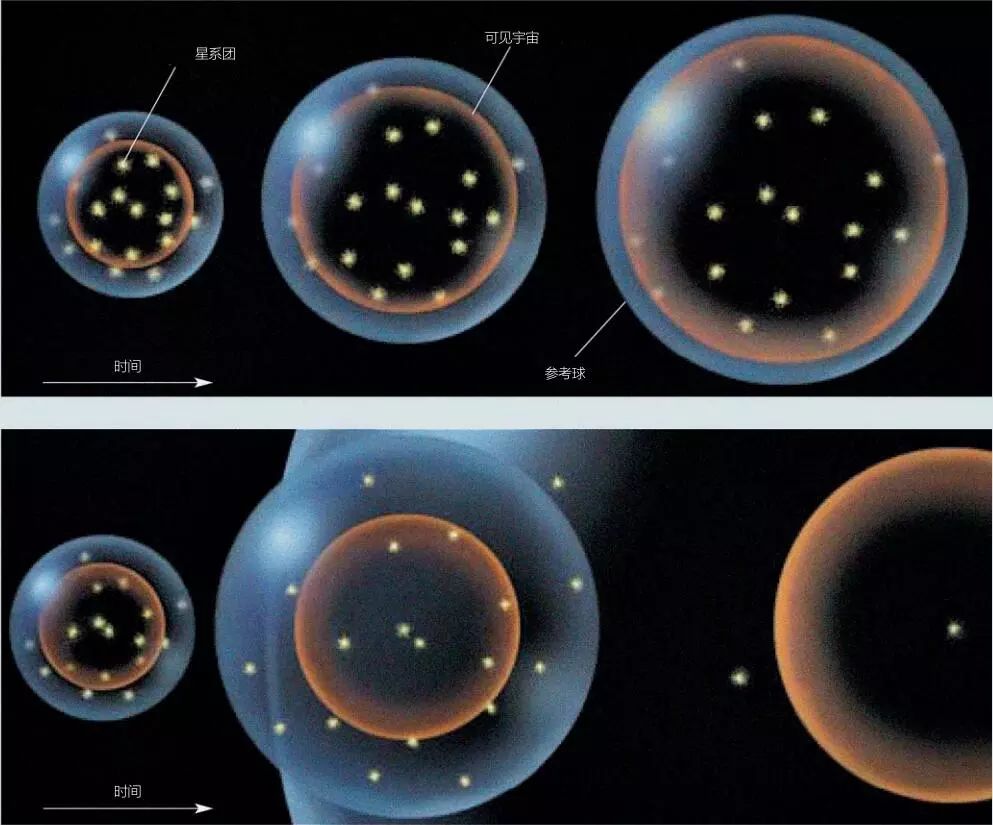
The results differ significantly between a decelerating universe (upper image series) and an accelerating universe (lower image series). In both cases, the universe is infinite, but the portion of the universe from the reference sphere to specific galaxies (blue sphere) will expand. Humanity can only see a limited portion of the universe around them, and as light signals have time to propagate (red sphere), this space will steadily increase. If the expansion is decelerating, the universe we see will increase, with more and more galaxies filling the space. However, if the expansion is accelerating, the universe we can see will decrease, as if the starry sky before us has been swept clean.
However, not all energy will be subject to “dilution.” For example, the universe may be filled with a network of cosmic strings that are infinitely long and thin but concentrated with energy, possibly formed due to uneven cooling in the early universe. During cosmic expansion, the energy per unit length of cosmic strings remains unchanged. Intelligent life could cut one and then gather at the loose end to begin using its energy. If the cosmic string network is infinite, the energy needs of intelligent life could be permanently satisfied. But the problem is, if biological beings can do this, then nature’s mechanisms can do the same. If a civilization finds a way to cut cosmic strings, the cosmic string network is likely to disintegrate as a result. For example, black holes may spontaneously appear on cosmic strings and consume them. Therefore, humanity can only consume a limited number of strings and cannot reach the other end of the strings. Ultimately, the entire cosmic string network will disappear, leaving a civilization devoid of energy.
Can we mine quantum vacuum energy? Let’s not forget that cosmic expansion may be driven by the cosmological constant (a form of energy that does not change with cosmic expansion). If this is the case, the vacuum will be filled with a peculiar form of radiation known as Gibbons-Hawking radiation or de Sitter radiation. Unfortunately, we cannot extract usable energy from this radiation. If quantum vacuum energy loses energy, it will drop to a lower energy state, but the vacuum is already at its lowest energy state.
No matter how clever we become, no matter how cooperative the universe is, one day we will face the exhaustion of energy. In that case, do we have other avenues to achieve the eternity of life?
A very obvious strategy is to consume less energy. Dyson first proposed a quantitative consumption plan. To reduce energy loss and maintain low consumption, we will ultimately adopt the method of lowering our body temperature. At the same time, we consider altering human genes so that the human body can function normally at temperatures below 310 K (37°C). However, human body temperature cannot be arbitrarily lowered, as the freezing point of blood has a definite lower limit. Perhaps ultimately, we will have to completely abandon our physical bodies.
From a futurist perspective, abandoning the body poses no fundamental difficulties. We only need to assume that consciousness does not need to rely on specific forms of organic molecules and can manifest in various forms, such as electronic beings and sentient interstellar clouds. Most modern philosophers and cognitive scientists believe that processes like rational thought can be performed by computers. We will not discuss the detailed specifics here. We have billions of years to design new “bodies” into which we can transfer our consciousness in the future. These new “bodies” can operate at cooler temperatures and have lower metabolic rates, thereby reducing energy consumption.
Dyson pointed out that as the universe gradually cools, if biological entities can lower their metabolic rates, they can manage to consume only a finite amount of energy over an infinitely long evolutionary process. Although the decrease in temperature means a slowdown in thinking speed (the number of thoughts considered per second), theoretically, such a thinking speed is still sufficient to ensure that our total number of thoughts remains unlimited. In summary, intelligent life will survive forever, whether in absolute time or subjective time. As long as biological beings can ensure endless thinking, they will not care if the pace of life slows down. If you have billions of years ahead of you, why rush?
At first glance, this seems like a good idea for conserving energy. But mathematically, infinity challenges intuition. Dyson states that for a biological entity to maintain the same level of complexity, the speed at which it processes information should be proportional to its temperature, while energy consumption should be proportional to the square of the temperature (another temperature factor arises from thermodynamics). Therefore, the degree of energy demand reduction must exceed the reduction in thinking speed. At 310 K (37°C), the human body consumes about 100 joules of energy per second, while at 155 K (-118°C), a similarly complex organism’s thinking speed drops to half, but the energy consumed drops to one-fourth of the original. This “trade-off” is acceptable because the physical processes in the surrounding environment will also slow down at the same rate.
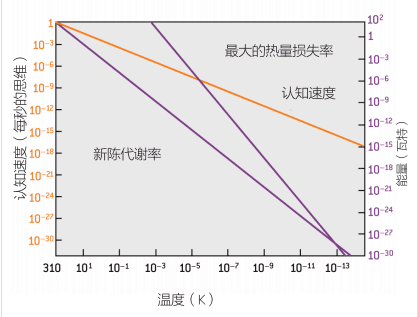
Can eternal life exist under limited energy? If new life can lower its body temperature below 310 K (37°C), it will consume less energy at the cost of slowing down thought. Since the metabolic rate decreases faster than the thinking speed, life can be designed in such a way—utilizing limited energy while possessing infinite thoughts. One point to note is that the ability of living beings to dissipate heat will also decrease, which will prevent them from further lowering their temperature below 10-13K.
Exchanging Hibernation for Immortality
Unfortunately, there is a trap here. If an object is not heated, most of its energy will be lost as thermal radiation; for example, human skin radiates infrared light. At very low temperatures, the most energy-efficient radiation is a thin electron gas. However, even with such optimal radiation efficiency—energy consumption is proportional to the cube of temperature—the rate of energy loss will still exceed the metabolic rate. When the temperature of a biological entity can no longer decrease, a turning point will occur—after that, they will have to reduce their higher functions and become lower-energy beings. Soon after, they will no longer be intelligent life.
For the weak, the outcome seems predetermined. However, to address the issue of energy loss, Dyson boldly designed a hibernation strategy, where organisms only need to remain awake for a small portion of the time. During hibernation, the metabolic rate of the organism will decrease, but crucially, they can continue to dissipate heat. This way, the average temperature of the organism can be lower. In fact, by continuously increasing the duration of hibernation, organisms can consume limited energy and exist forever, with their number of thoughts remaining unlimited. Dyson concluded: eternal life is indeed possible!
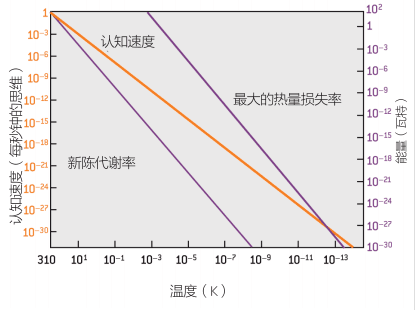
Hibernation may solve the energy consumption problem. When life enters a cooling mode, it will spend more time in hibernation, further reducing the average speed of metabolism and thought. At this point, the energy consumed is lower than the maximum rate of heat loss, while still allowing for infinite thoughts. However, such a design has other issues, such as potential conflicts with quantum limits.
However, many scientists have raised doubts about Dyson’s plan, pointing out the difficulties in its implementation. First, Dyson assumes that the average temperature of outer space (currently 2.7 K) is determined by microwave background radiation, which will forever decrease with the expansion of the universe, allowing biological beings to lower their temperature indefinitely. However, if a cosmological constant exists, the temperature will be limited by Gibbons-Hawking radiation, which has a lower limit. Based on current estimates of the cosmological constant, this radiation has a temperature limit of about 10-29K. We note that if biological entities’ body temperature drops to this point, they will not be able to further lower their temperature to conserve energy.
Secondly, Dyson’s plan requires an alarm clock to periodically wake the organisms. These alarms must operate very precisely, consuming less energy each time while extending the interval between operations. Quantum mechanics indicates that this is impossible. Imagine an alarm clock consisting of two small balls, first pulling them apart and then releasing them to collide. When the two balls collide, the alarm rings. To extend the interval of the alarm, the biological entity must release the balls at a slower speed. However, eventually, the alarm will encounter the limitations of the Heisenberg uncertainty principle, which states that it is impossible to achieve arbitrary precision in both the speed and position of the balls simultaneously. If one of the balls is not accurate enough, the alarm will fail, resulting in hibernation turning into permanent sleep.
You might want to design another form of clock that is forever free from quantum mechanical limitations, or even integrate it into the biological entity itself. However, no one has yet designed such a special device that can reliably wake organisms without consuming energy.
The Cage of Immortality
Also, the most fundamental question regarding the long-term evolution of intelligent life is the basic limitations of computational capacity. Computer scientists once believed that a certain amount of energy would inevitably be consumed with each computation, and that this energy was proportional to the temperature of the computer. However, in the early 1980s, researchers discovered that certain physical processes, such as quantum effects and random Brownian motion of particles in liquids, could serve as the main components of a zero-energy computer.
Such computers could operate under conditions of negligible energy consumption. Eternal biological entities could also achieve reduced energy consumption by simply slowing down. But this requires two conditions to be met. First, they must maintain thermal equilibrium with their surroundings; second, they must never lose information. If they fail to do so, i.e., if computation becomes irreversible, then this irreversible thermodynamic process will inevitably consume energy.
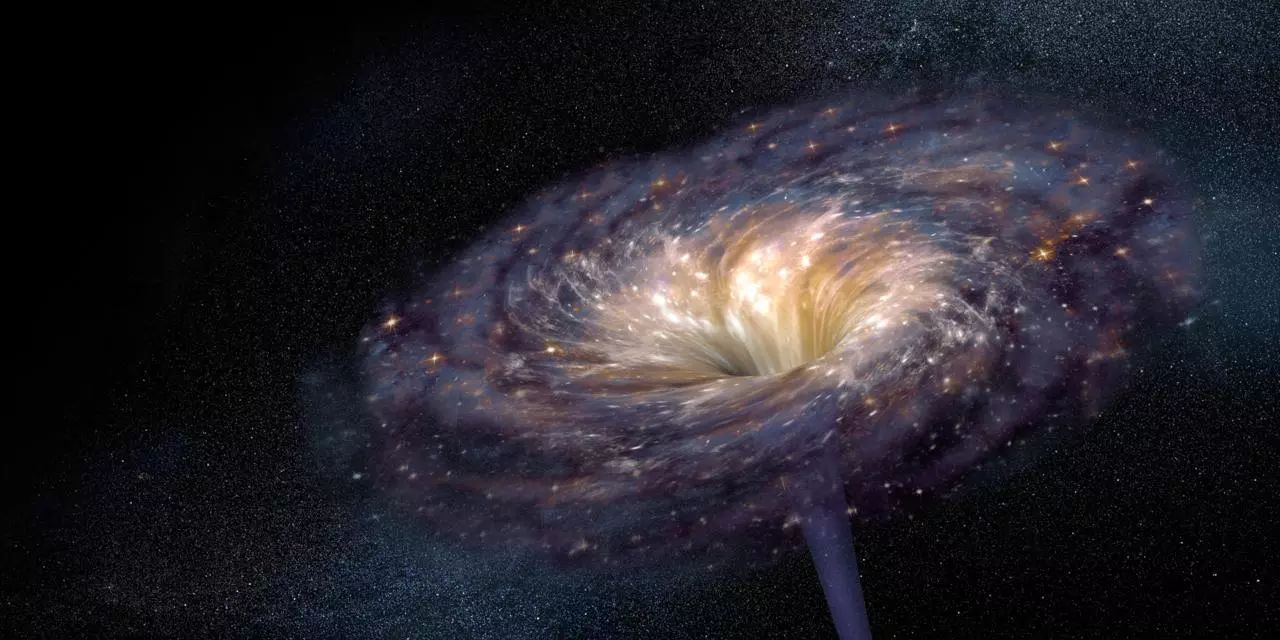
Sadly, for an expanding universe, those conditions are insurmountable. During cosmic expansion, due to dilution and wavelength stretching, biological entities become unable to emit and absorb radiation, thus failing to achieve thermal equilibrium with their surroundings. Moreover, because they can only process a limited amount of matter, their memory is also limited, so to gain new ideas, they must abandon previous ones. Theoretically, in what form could such beings exist eternally?
They can only collect a finite number of particles and information, and these particles and information can only exist in certain forms. Since thoughts are a reorganization of information, limited information means limited thoughts. All life can do is relive the past, continuously repeating the same thoughts. Eternity becomes a “cage” rather than a process of endless innovation and exploration. This may be a paradise, but can such life be considered truly alive?
It is worth mentioning that Dyson has never given up hope. In our communications, he pointed out that humanity can bypass the limitations of quantum mechanics on energy and information, for example, by increasing size or adopting different forms of thought. He creatively proposed that the key to the problem lies in whether life is “analog” or “digital”—that is, whether the limits of life are determined by “continuous physics” or quantum physics. We believe that after a considerable journey, life will be “digital.”
Are there other hopes for eternal life? The quantum mechanics that strongly obstructs eternal life may, perhaps, save it through another avenue. For instance, if quantum gravity theory allows for stable wormholes, the material of life could manage to bypass the light-speed barrier, accessing parts of the universe that are otherwise unreachable, gathering an infinite amount of energy and information. Alternatively, they could construct a “baby” universe and send themselves, or a series of instructions to reorganize themselves, into this “baby” universe. In this way, life could continue.
Regardless, it seems premature to discuss the ultimate limits of life; only on the true cosmological time scale will it become significant. However, this question will still unsettle some, as it is certain that our physical embodiments will have an end. But think about it, how wonderful it is that we can draw conclusions on such significant issues despite our limited knowledge!
Perhaps understanding the fascinating universe and humanity itself is more meaningful than eternally residing in physical forms.
The translator of this article, Jianrong Shi, is a researcher at the National Astronomical Observatory, specializing in determining the elemental abundances of stars, particularly the study of non-local thermodynamic equilibrium effects in the atmospheres of late-type stars and the chemical evolution of the Milky Way.

Global Science February issue is now on sale
Welcome to click read the original to purchase
